Organizational Culture: Strategies for Managing Change Resistance
VerifiedAdded on 2020/03/04
|10
|2276
|45
Essay
AI Summary
This essay delves into the critical relationship between organizational culture and employee resistance to change. It begins by defining organizational culture and its impact on employee behavior, highlighting observable and unobservable elements like shared values and norms. The essay then discusses the importance of adapting to change in today's business environment and identifies key reasons for employee resistance, including job security concerns, lack of rewards, fear of failure, peer pressure, and disruption of routines. The core of the essay focuses on how organizational culture can effectively respond to and mitigate this resistance. It explores internal factors such as setting SMART objectives, effective conflict management, employee empowerment, training and development, and incentives. Additionally, it examines external factors like career growth opportunities, the organization's competitive advantage, and customer requirements. The conclusion emphasizes the importance of a well-defined organizational culture in driving successful change management and employee adaptation, suggesting that addressing the root causes of resistance through strategic cultural initiatives is key to achieving positive outcomes.

Organisational culture and responses to overcoming
resistance to change
1 | P a g e
resistance to change
1 | P a g e
Paraphrase This Document
Need a fresh take? Get an instant paraphrase of this document with our AI Paraphraser
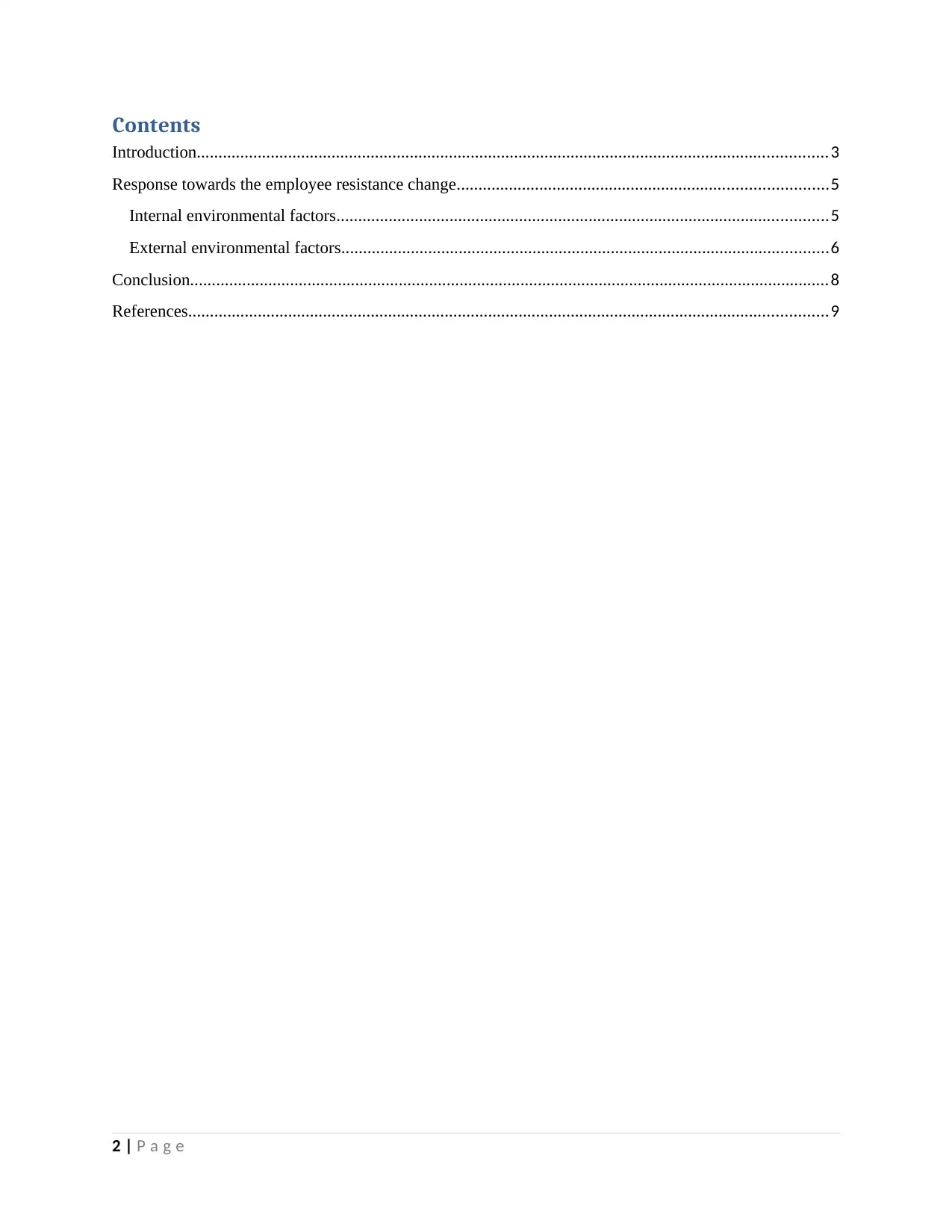
Contents
Introduction.................................................................................................................................................3
Response towards the employee resistance change.....................................................................................5
Internal environmental factors.................................................................................................................5
External environmental factors................................................................................................................6
Conclusion...................................................................................................................................................8
References...................................................................................................................................................9
2 | P a g e
Introduction.................................................................................................................................................3
Response towards the employee resistance change.....................................................................................5
Internal environmental factors.................................................................................................................5
External environmental factors................................................................................................................6
Conclusion...................................................................................................................................................8
References...................................................................................................................................................9
2 | P a g e
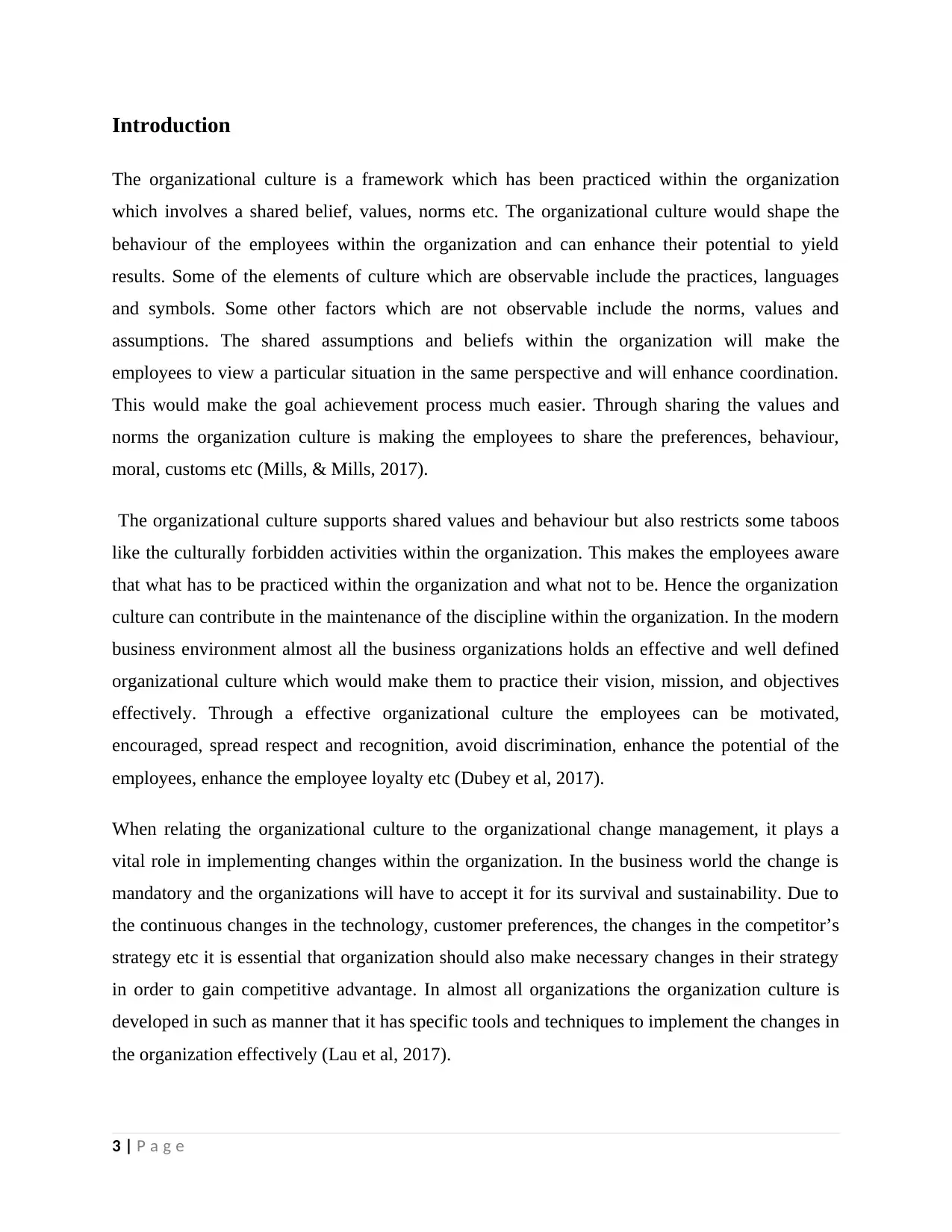
Introduction
The organizational culture is a framework which has been practiced within the organization
which involves a shared belief, values, norms etc. The organizational culture would shape the
behaviour of the employees within the organization and can enhance their potential to yield
results. Some of the elements of culture which are observable include the practices, languages
and symbols. Some other factors which are not observable include the norms, values and
assumptions. The shared assumptions and beliefs within the organization will make the
employees to view a particular situation in the same perspective and will enhance coordination.
This would make the goal achievement process much easier. Through sharing the values and
norms the organization culture is making the employees to share the preferences, behaviour,
moral, customs etc (Mills, & Mills, 2017).
The organizational culture supports shared values and behaviour but also restricts some taboos
like the culturally forbidden activities within the organization. This makes the employees aware
that what has to be practiced within the organization and what not to be. Hence the organization
culture can contribute in the maintenance of the discipline within the organization. In the modern
business environment almost all the business organizations holds an effective and well defined
organizational culture which would make them to practice their vision, mission, and objectives
effectively. Through a effective organizational culture the employees can be motivated,
encouraged, spread respect and recognition, avoid discrimination, enhance the potential of the
employees, enhance the employee loyalty etc (Dubey et al, 2017).
When relating the organizational culture to the organizational change management, it plays a
vital role in implementing changes within the organization. In the business world the change is
mandatory and the organizations will have to accept it for its survival and sustainability. Due to
the continuous changes in the technology, customer preferences, the changes in the competitor’s
strategy etc it is essential that organization should also make necessary changes in their strategy
in order to gain competitive advantage. In almost all organizations the organization culture is
developed in such as manner that it has specific tools and techniques to implement the changes in
the organization effectively (Lau et al, 2017).
3 | P a g e
The organizational culture is a framework which has been practiced within the organization
which involves a shared belief, values, norms etc. The organizational culture would shape the
behaviour of the employees within the organization and can enhance their potential to yield
results. Some of the elements of culture which are observable include the practices, languages
and symbols. Some other factors which are not observable include the norms, values and
assumptions. The shared assumptions and beliefs within the organization will make the
employees to view a particular situation in the same perspective and will enhance coordination.
This would make the goal achievement process much easier. Through sharing the values and
norms the organization culture is making the employees to share the preferences, behaviour,
moral, customs etc (Mills, & Mills, 2017).
The organizational culture supports shared values and behaviour but also restricts some taboos
like the culturally forbidden activities within the organization. This makes the employees aware
that what has to be practiced within the organization and what not to be. Hence the organization
culture can contribute in the maintenance of the discipline within the organization. In the modern
business environment almost all the business organizations holds an effective and well defined
organizational culture which would make them to practice their vision, mission, and objectives
effectively. Through a effective organizational culture the employees can be motivated,
encouraged, spread respect and recognition, avoid discrimination, enhance the potential of the
employees, enhance the employee loyalty etc (Dubey et al, 2017).
When relating the organizational culture to the organizational change management, it plays a
vital role in implementing changes within the organization. In the business world the change is
mandatory and the organizations will have to accept it for its survival and sustainability. Due to
the continuous changes in the technology, customer preferences, the changes in the competitor’s
strategy etc it is essential that organization should also make necessary changes in their strategy
in order to gain competitive advantage. In almost all organizations the organization culture is
developed in such as manner that it has specific tools and techniques to implement the changes in
the organization effectively (Lau et al, 2017).
3 | P a g e
⊘ This is a preview!⊘
Do you want full access?
Subscribe today to unlock all pages.

Trusted by 1+ million students worldwide
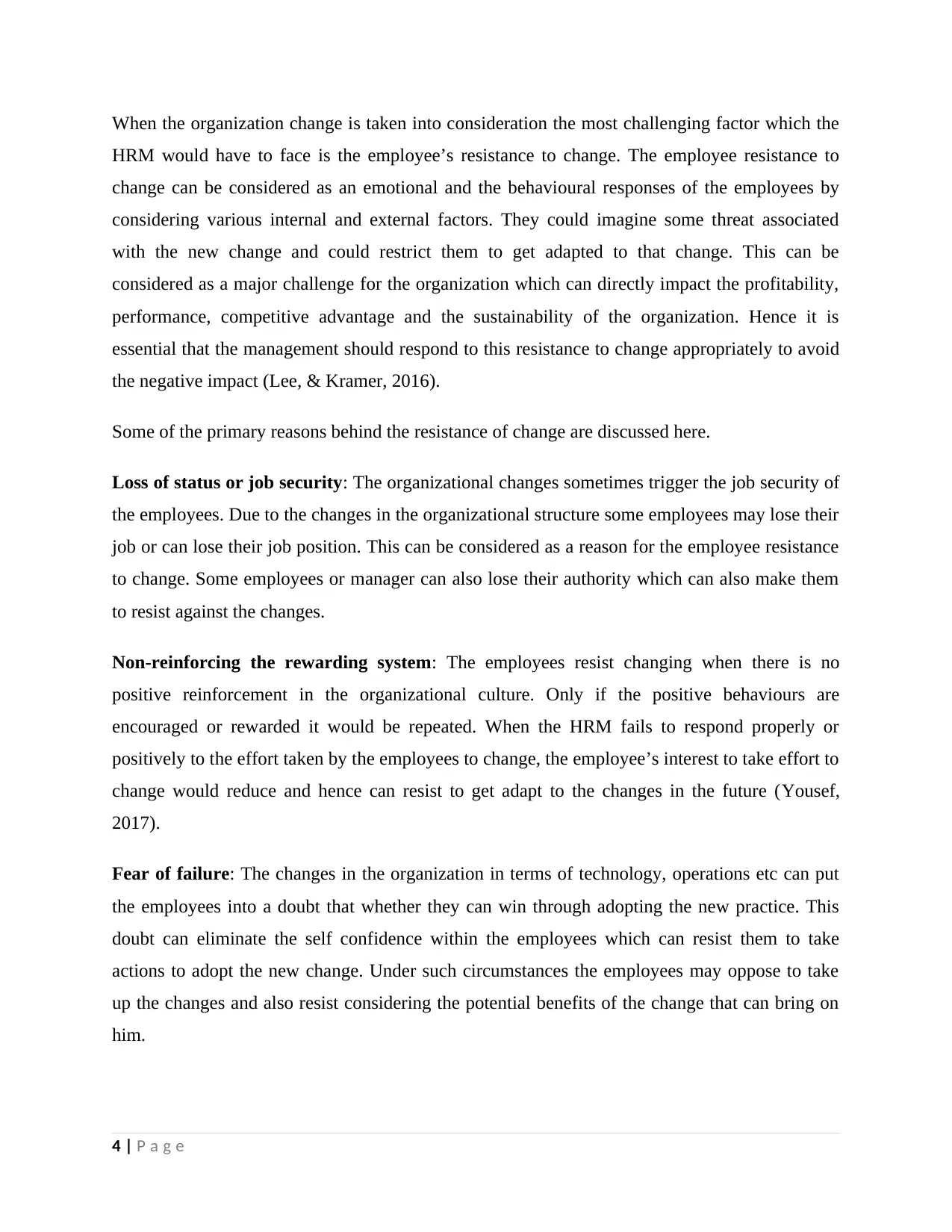
When the organization change is taken into consideration the most challenging factor which the
HRM would have to face is the employee’s resistance to change. The employee resistance to
change can be considered as an emotional and the behavioural responses of the employees by
considering various internal and external factors. They could imagine some threat associated
with the new change and could restrict them to get adapted to that change. This can be
considered as a major challenge for the organization which can directly impact the profitability,
performance, competitive advantage and the sustainability of the organization. Hence it is
essential that the management should respond to this resistance to change appropriately to avoid
the negative impact (Lee, & Kramer, 2016).
Some of the primary reasons behind the resistance of change are discussed here.
Loss of status or job security: The organizational changes sometimes trigger the job security of
the employees. Due to the changes in the organizational structure some employees may lose their
job or can lose their job position. This can be considered as a reason for the employee resistance
to change. Some employees or manager can also lose their authority which can also make them
to resist against the changes.
Non-reinforcing the rewarding system: The employees resist changing when there is no
positive reinforcement in the organizational culture. Only if the positive behaviours are
encouraged or rewarded it would be repeated. When the HRM fails to respond properly or
positively to the effort taken by the employees to change, the employee’s interest to take effort to
change would reduce and hence can resist to get adapt to the changes in the future (Yousef,
2017).
Fear of failure: The changes in the organization in terms of technology, operations etc can put
the employees into a doubt that whether they can win through adopting the new practice. This
doubt can eliminate the self confidence within the employees which can resist them to take
actions to adopt the new change. Under such circumstances the employees may oppose to take
up the changes and also resist considering the potential benefits of the change that can bring on
him.
4 | P a g e
HRM would have to face is the employee’s resistance to change. The employee resistance to
change can be considered as an emotional and the behavioural responses of the employees by
considering various internal and external factors. They could imagine some threat associated
with the new change and could restrict them to get adapted to that change. This can be
considered as a major challenge for the organization which can directly impact the profitability,
performance, competitive advantage and the sustainability of the organization. Hence it is
essential that the management should respond to this resistance to change appropriately to avoid
the negative impact (Lee, & Kramer, 2016).
Some of the primary reasons behind the resistance of change are discussed here.
Loss of status or job security: The organizational changes sometimes trigger the job security of
the employees. Due to the changes in the organizational structure some employees may lose their
job or can lose their job position. This can be considered as a reason for the employee resistance
to change. Some employees or manager can also lose their authority which can also make them
to resist against the changes.
Non-reinforcing the rewarding system: The employees resist changing when there is no
positive reinforcement in the organizational culture. Only if the positive behaviours are
encouraged or rewarded it would be repeated. When the HRM fails to respond properly or
positively to the effort taken by the employees to change, the employee’s interest to take effort to
change would reduce and hence can resist to get adapt to the changes in the future (Yousef,
2017).
Fear of failure: The changes in the organization in terms of technology, operations etc can put
the employees into a doubt that whether they can win through adopting the new practice. This
doubt can eliminate the self confidence within the employees which can resist them to take
actions to adopt the new change. Under such circumstances the employees may oppose to take
up the changes and also resist considering the potential benefits of the change that can bring on
him.
4 | P a g e
Paraphrase This Document
Need a fresh take? Get an instant paraphrase of this document with our AI Paraphraser
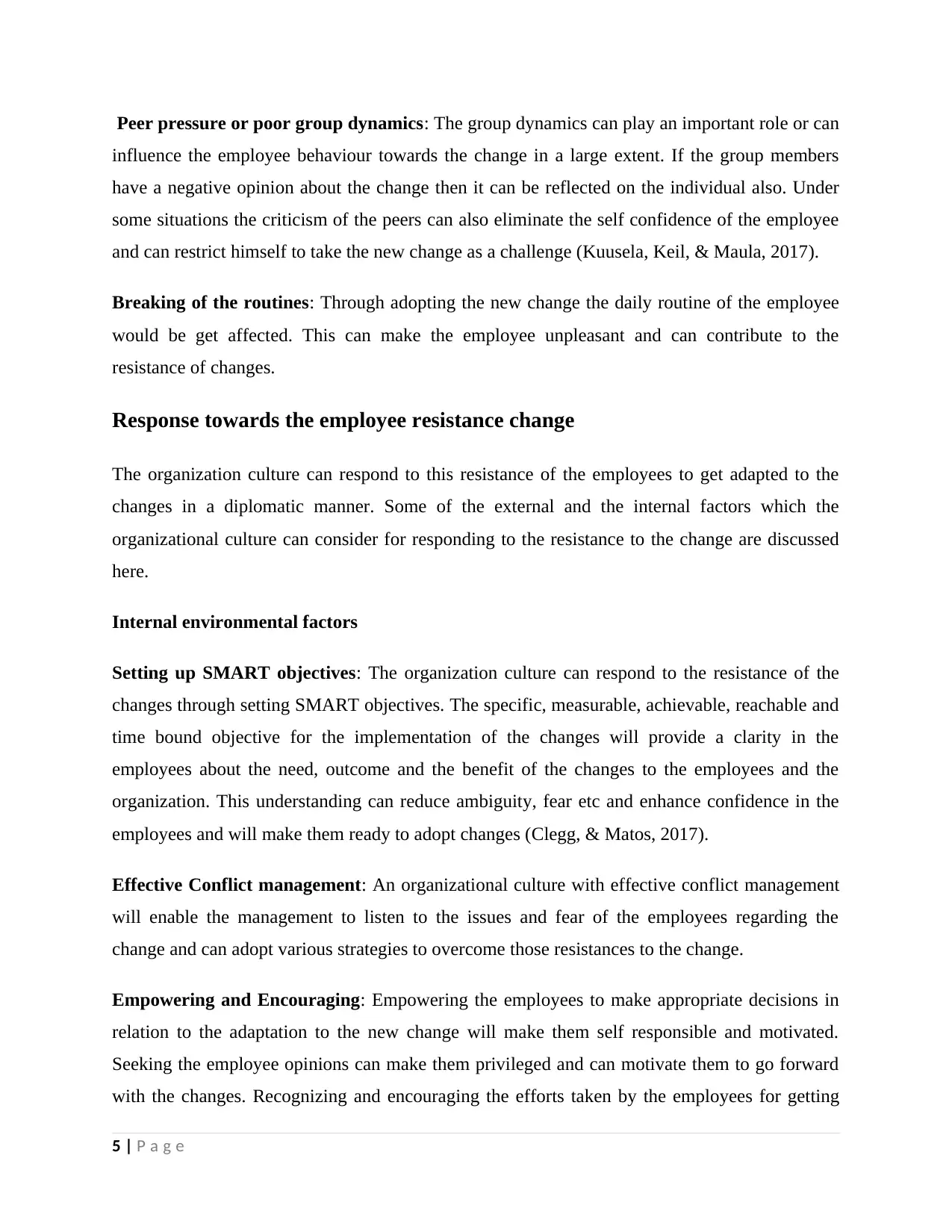
Peer pressure or poor group dynamics: The group dynamics can play an important role or can
influence the employee behaviour towards the change in a large extent. If the group members
have a negative opinion about the change then it can be reflected on the individual also. Under
some situations the criticism of the peers can also eliminate the self confidence of the employee
and can restrict himself to take the new change as a challenge (Kuusela, Keil, & Maula, 2017).
Breaking of the routines: Through adopting the new change the daily routine of the employee
would be get affected. This can make the employee unpleasant and can contribute to the
resistance of changes.
Response towards the employee resistance change
The organization culture can respond to this resistance of the employees to get adapted to the
changes in a diplomatic manner. Some of the external and the internal factors which the
organizational culture can consider for responding to the resistance to the change are discussed
here.
Internal environmental factors
Setting up SMART objectives: The organization culture can respond to the resistance of the
changes through setting SMART objectives. The specific, measurable, achievable, reachable and
time bound objective for the implementation of the changes will provide a clarity in the
employees about the need, outcome and the benefit of the changes to the employees and the
organization. This understanding can reduce ambiguity, fear etc and enhance confidence in the
employees and will make them ready to adopt changes (Clegg, & Matos, 2017).
Effective Conflict management: An organizational culture with effective conflict management
will enable the management to listen to the issues and fear of the employees regarding the
change and can adopt various strategies to overcome those resistances to the change.
Empowering and Encouraging: Empowering the employees to make appropriate decisions in
relation to the adaptation to the new change will make them self responsible and motivated.
Seeking the employee opinions can make them privileged and can motivate them to go forward
with the changes. Recognizing and encouraging the efforts taken by the employees for getting
5 | P a g e
influence the employee behaviour towards the change in a large extent. If the group members
have a negative opinion about the change then it can be reflected on the individual also. Under
some situations the criticism of the peers can also eliminate the self confidence of the employee
and can restrict himself to take the new change as a challenge (Kuusela, Keil, & Maula, 2017).
Breaking of the routines: Through adopting the new change the daily routine of the employee
would be get affected. This can make the employee unpleasant and can contribute to the
resistance of changes.
Response towards the employee resistance change
The organization culture can respond to this resistance of the employees to get adapted to the
changes in a diplomatic manner. Some of the external and the internal factors which the
organizational culture can consider for responding to the resistance to the change are discussed
here.
Internal environmental factors
Setting up SMART objectives: The organization culture can respond to the resistance of the
changes through setting SMART objectives. The specific, measurable, achievable, reachable and
time bound objective for the implementation of the changes will provide a clarity in the
employees about the need, outcome and the benefit of the changes to the employees and the
organization. This understanding can reduce ambiguity, fear etc and enhance confidence in the
employees and will make them ready to adopt changes (Clegg, & Matos, 2017).
Effective Conflict management: An organizational culture with effective conflict management
will enable the management to listen to the issues and fear of the employees regarding the
change and can adopt various strategies to overcome those resistances to the change.
Empowering and Encouraging: Empowering the employees to make appropriate decisions in
relation to the adaptation to the new change will make them self responsible and motivated.
Seeking the employee opinions can make them privileged and can motivate them to go forward
with the changes. Recognizing and encouraging the efforts taken by the employees for getting
5 | P a g e
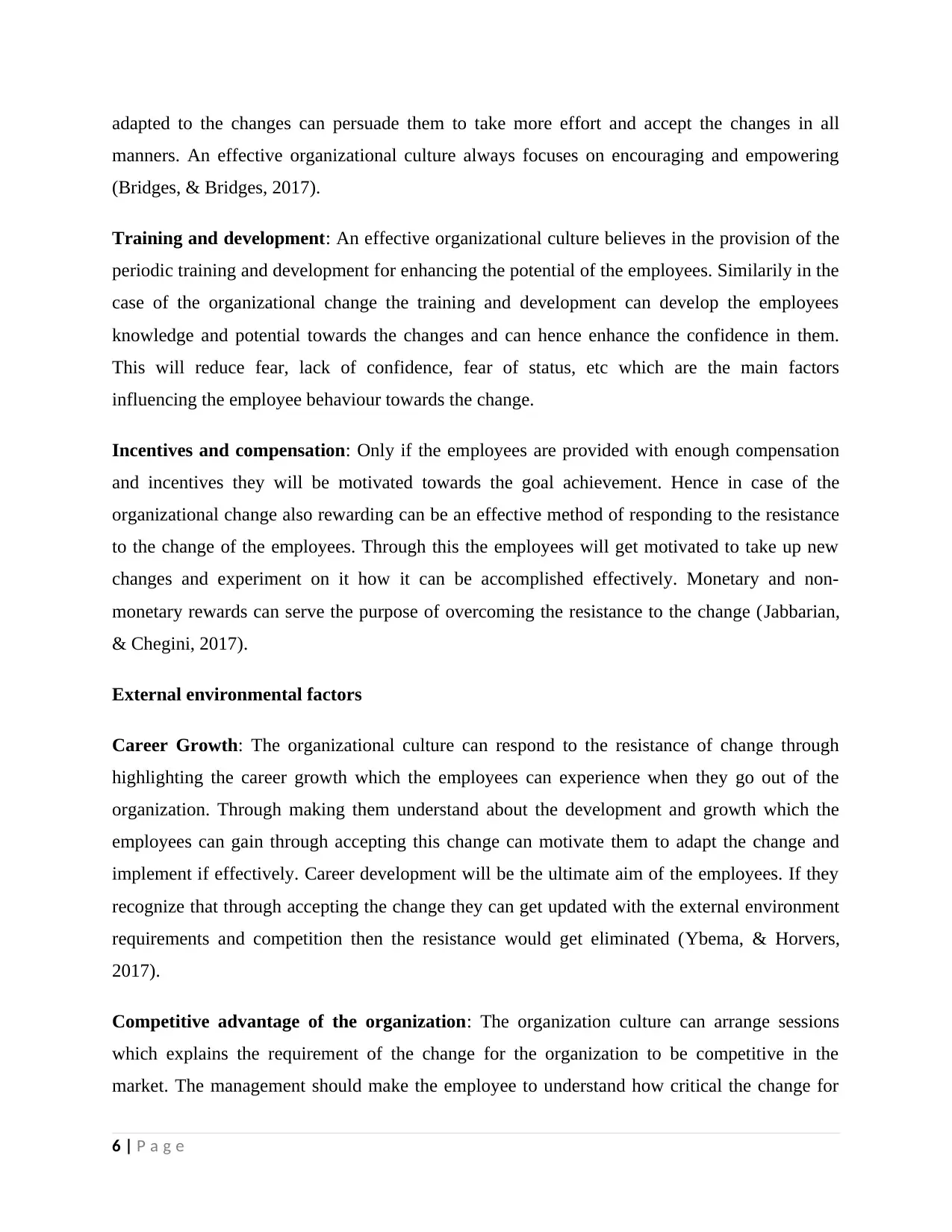
adapted to the changes can persuade them to take more effort and accept the changes in all
manners. An effective organizational culture always focuses on encouraging and empowering
(Bridges, & Bridges, 2017).
Training and development: An effective organizational culture believes in the provision of the
periodic training and development for enhancing the potential of the employees. Similarily in the
case of the organizational change the training and development can develop the employees
knowledge and potential towards the changes and can hence enhance the confidence in them.
This will reduce fear, lack of confidence, fear of status, etc which are the main factors
influencing the employee behaviour towards the change.
Incentives and compensation: Only if the employees are provided with enough compensation
and incentives they will be motivated towards the goal achievement. Hence in case of the
organizational change also rewarding can be an effective method of responding to the resistance
to the change of the employees. Through this the employees will get motivated to take up new
changes and experiment on it how it can be accomplished effectively. Monetary and non-
monetary rewards can serve the purpose of overcoming the resistance to the change (Jabbarian,
& Chegini, 2017).
External environmental factors
Career Growth: The organizational culture can respond to the resistance of change through
highlighting the career growth which the employees can experience when they go out of the
organization. Through making them understand about the development and growth which the
employees can gain through accepting this change can motivate them to adapt the change and
implement if effectively. Career development will be the ultimate aim of the employees. If they
recognize that through accepting the change they can get updated with the external environment
requirements and competition then the resistance would get eliminated (Ybema, & Horvers,
2017).
Competitive advantage of the organization: The organization culture can arrange sessions
which explains the requirement of the change for the organization to be competitive in the
market. The management should make the employee to understand how critical the change for
6 | P a g e
manners. An effective organizational culture always focuses on encouraging and empowering
(Bridges, & Bridges, 2017).
Training and development: An effective organizational culture believes in the provision of the
periodic training and development for enhancing the potential of the employees. Similarily in the
case of the organizational change the training and development can develop the employees
knowledge and potential towards the changes and can hence enhance the confidence in them.
This will reduce fear, lack of confidence, fear of status, etc which are the main factors
influencing the employee behaviour towards the change.
Incentives and compensation: Only if the employees are provided with enough compensation
and incentives they will be motivated towards the goal achievement. Hence in case of the
organizational change also rewarding can be an effective method of responding to the resistance
to the change of the employees. Through this the employees will get motivated to take up new
changes and experiment on it how it can be accomplished effectively. Monetary and non-
monetary rewards can serve the purpose of overcoming the resistance to the change (Jabbarian,
& Chegini, 2017).
External environmental factors
Career Growth: The organizational culture can respond to the resistance of change through
highlighting the career growth which the employees can experience when they go out of the
organization. Through making them understand about the development and growth which the
employees can gain through accepting this change can motivate them to adapt the change and
implement if effectively. Career development will be the ultimate aim of the employees. If they
recognize that through accepting the change they can get updated with the external environment
requirements and competition then the resistance would get eliminated (Ybema, & Horvers,
2017).
Competitive advantage of the organization: The organization culture can arrange sessions
which explains the requirement of the change for the organization to be competitive in the
market. The management should make the employee to understand how critical the change for
6 | P a g e
⊘ This is a preview!⊘
Do you want full access?
Subscribe today to unlock all pages.

Trusted by 1+ million students worldwide
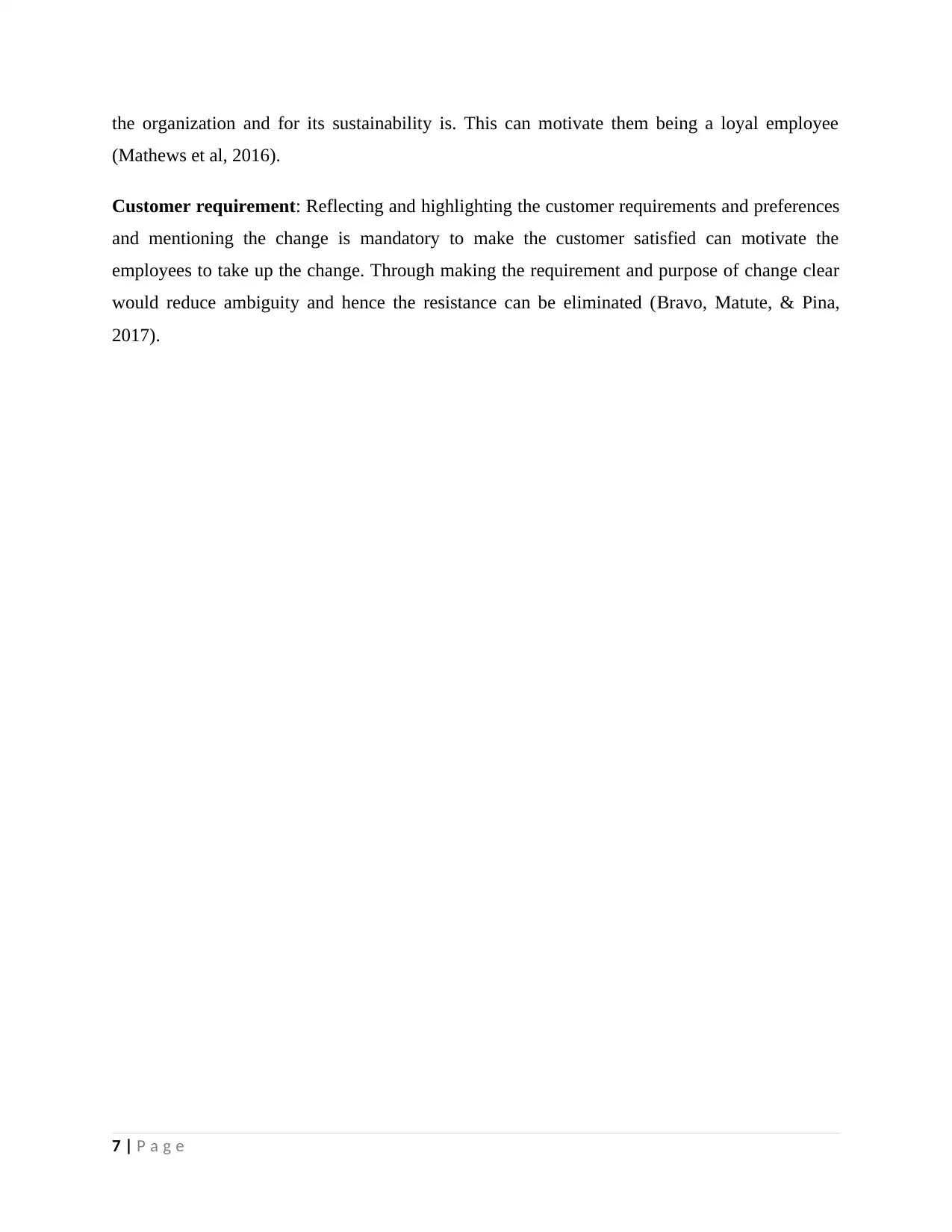
the organization and for its sustainability is. This can motivate them being a loyal employee
(Mathews et al, 2016).
Customer requirement: Reflecting and highlighting the customer requirements and preferences
and mentioning the change is mandatory to make the customer satisfied can motivate the
employees to take up the change. Through making the requirement and purpose of change clear
would reduce ambiguity and hence the resistance can be eliminated (Bravo, Matute, & Pina,
2017).
7 | P a g e
(Mathews et al, 2016).
Customer requirement: Reflecting and highlighting the customer requirements and preferences
and mentioning the change is mandatory to make the customer satisfied can motivate the
employees to take up the change. Through making the requirement and purpose of change clear
would reduce ambiguity and hence the resistance can be eliminated (Bravo, Matute, & Pina,
2017).
7 | P a g e
Paraphrase This Document
Need a fresh take? Get an instant paraphrase of this document with our AI Paraphraser
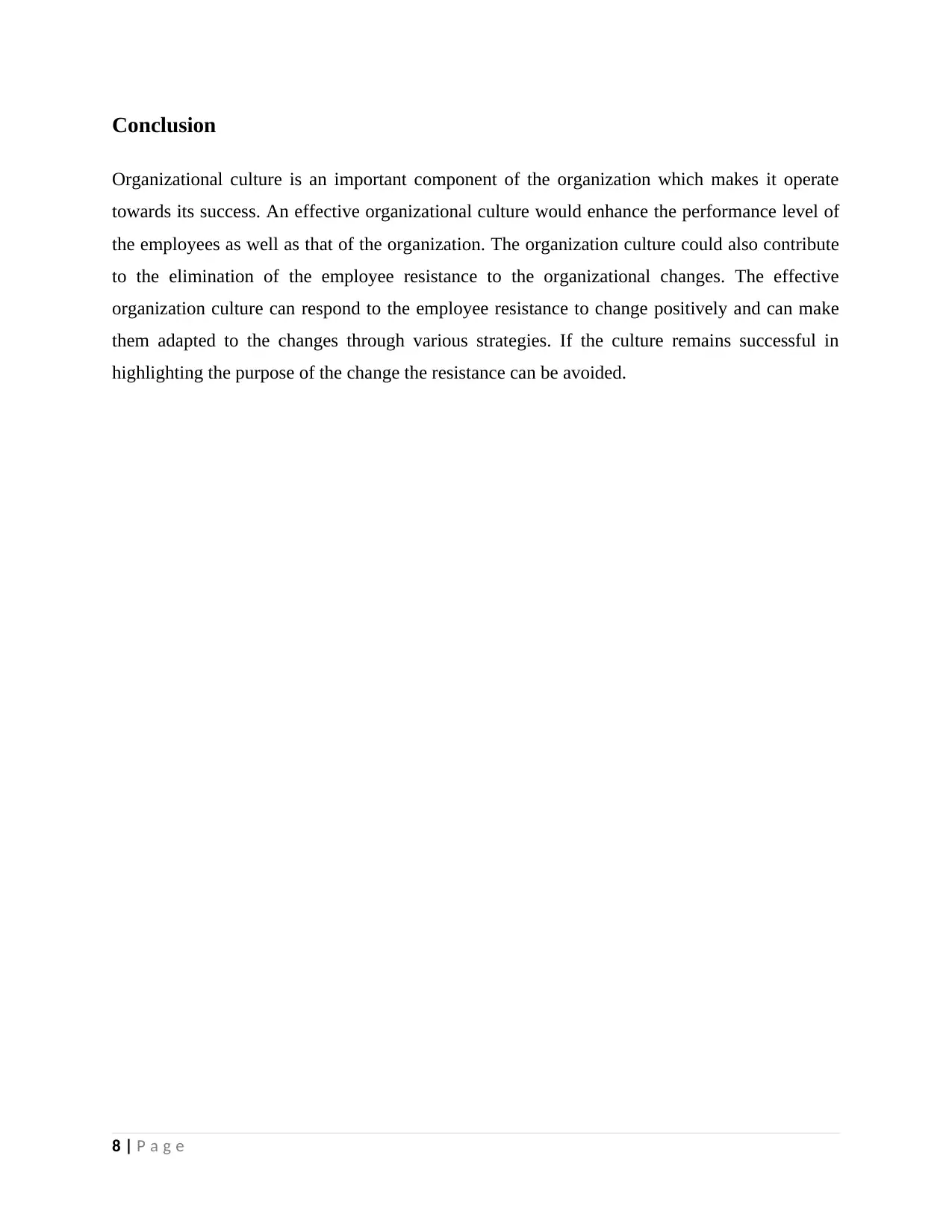
Conclusion
Organizational culture is an important component of the organization which makes it operate
towards its success. An effective organizational culture would enhance the performance level of
the employees as well as that of the organization. The organization culture could also contribute
to the elimination of the employee resistance to the organizational changes. The effective
organization culture can respond to the employee resistance to change positively and can make
them adapted to the changes through various strategies. If the culture remains successful in
highlighting the purpose of the change the resistance can be avoided.
8 | P a g e
Organizational culture is an important component of the organization which makes it operate
towards its success. An effective organizational culture would enhance the performance level of
the employees as well as that of the organization. The organization culture could also contribute
to the elimination of the employee resistance to the organizational changes. The effective
organization culture can respond to the employee resistance to change positively and can make
them adapted to the changes through various strategies. If the culture remains successful in
highlighting the purpose of the change the resistance can be avoided.
8 | P a g e
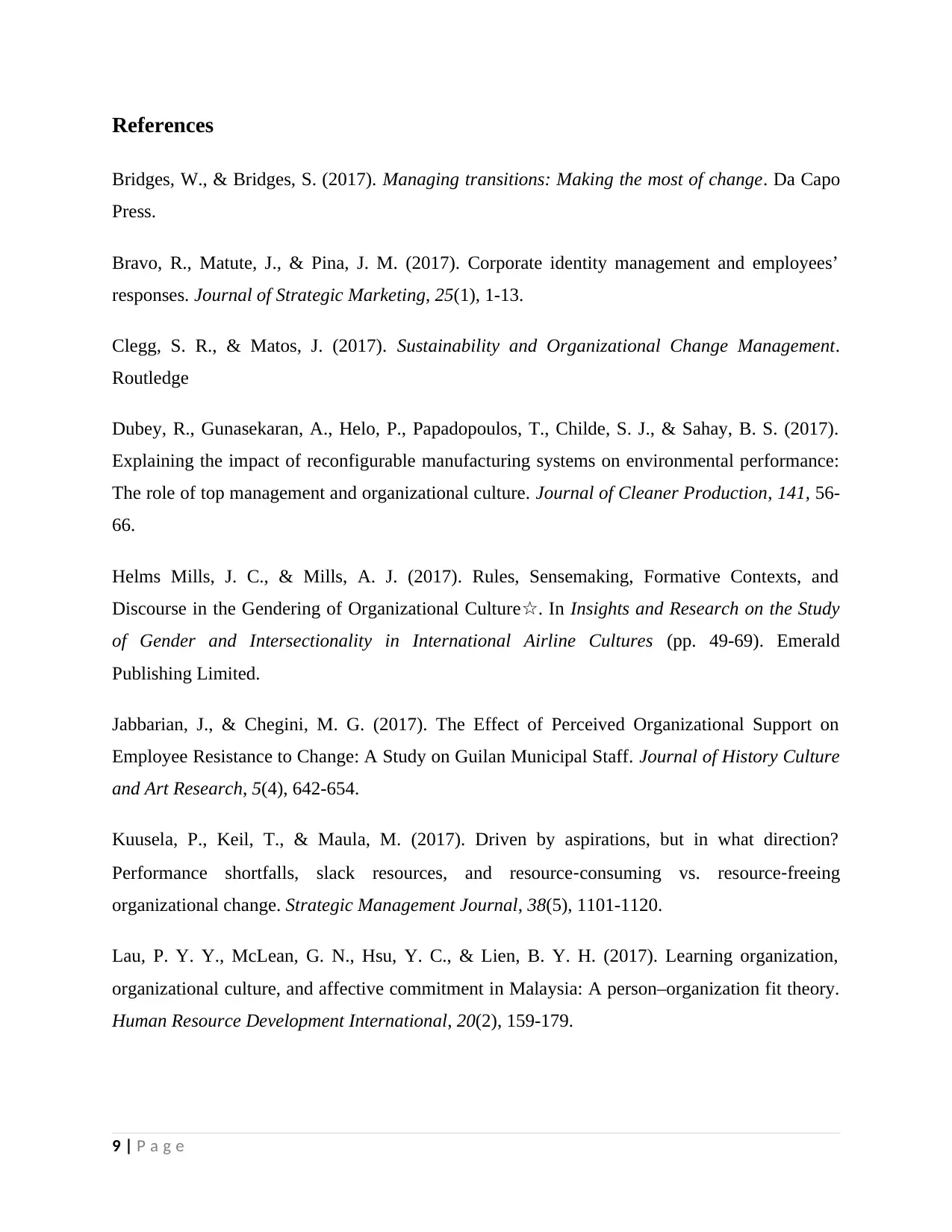
References
Bridges, W., & Bridges, S. (2017). Managing transitions: Making the most of change. Da Capo
Press.
Bravo, R., Matute, J., & Pina, J. M. (2017). Corporate identity management and employees’
responses. Journal of Strategic Marketing, 25(1), 1-13.
Clegg, S. R., & Matos, J. (2017). Sustainability and Organizational Change Management.
Routledge
Dubey, R., Gunasekaran, A., Helo, P., Papadopoulos, T., Childe, S. J., & Sahay, B. S. (2017).
Explaining the impact of reconfigurable manufacturing systems on environmental performance:
The role of top management and organizational culture. Journal of Cleaner Production, 141, 56-
66.
Helms Mills, J. C., & Mills, A. J. (2017). Rules, Sensemaking, Formative Contexts, and
Discourse in the Gendering of Organizational Culture☆. In Insights and Research on the Study
of Gender and Intersectionality in International Airline Cultures (pp. 49-69). Emerald
Publishing Limited.
Jabbarian, J., & Chegini, M. G. (2017). The Effect of Perceived Organizational Support on
Employee Resistance to Change: A Study on Guilan Municipal Staff. Journal of History Culture
and Art Research, 5(4), 642-654.
Kuusela, P., Keil, T., & Maula, M. (2017). Driven by aspirations, but in what direction?
Performance shortfalls, slack resources, and resource‐consuming vs. resource‐freeing
organizational change. Strategic Management Journal, 38(5), 1101-1120.
Lau, P. Y. Y., McLean, G. N., Hsu, Y. C., & Lien, B. Y. H. (2017). Learning organization,
organizational culture, and affective commitment in Malaysia: A person–organization fit theory.
Human Resource Development International, 20(2), 159-179.
9 | P a g e
Bridges, W., & Bridges, S. (2017). Managing transitions: Making the most of change. Da Capo
Press.
Bravo, R., Matute, J., & Pina, J. M. (2017). Corporate identity management and employees’
responses. Journal of Strategic Marketing, 25(1), 1-13.
Clegg, S. R., & Matos, J. (2017). Sustainability and Organizational Change Management.
Routledge
Dubey, R., Gunasekaran, A., Helo, P., Papadopoulos, T., Childe, S. J., & Sahay, B. S. (2017).
Explaining the impact of reconfigurable manufacturing systems on environmental performance:
The role of top management and organizational culture. Journal of Cleaner Production, 141, 56-
66.
Helms Mills, J. C., & Mills, A. J. (2017). Rules, Sensemaking, Formative Contexts, and
Discourse in the Gendering of Organizational Culture☆. In Insights and Research on the Study
of Gender and Intersectionality in International Airline Cultures (pp. 49-69). Emerald
Publishing Limited.
Jabbarian, J., & Chegini, M. G. (2017). The Effect of Perceived Organizational Support on
Employee Resistance to Change: A Study on Guilan Municipal Staff. Journal of History Culture
and Art Research, 5(4), 642-654.
Kuusela, P., Keil, T., & Maula, M. (2017). Driven by aspirations, but in what direction?
Performance shortfalls, slack resources, and resource‐consuming vs. resource‐freeing
organizational change. Strategic Management Journal, 38(5), 1101-1120.
Lau, P. Y. Y., McLean, G. N., Hsu, Y. C., & Lien, B. Y. H. (2017). Learning organization,
organizational culture, and affective commitment in Malaysia: A person–organization fit theory.
Human Resource Development International, 20(2), 159-179.
9 | P a g e
⊘ This is a preview!⊘
Do you want full access?
Subscribe today to unlock all pages.

Trusted by 1+ million students worldwide
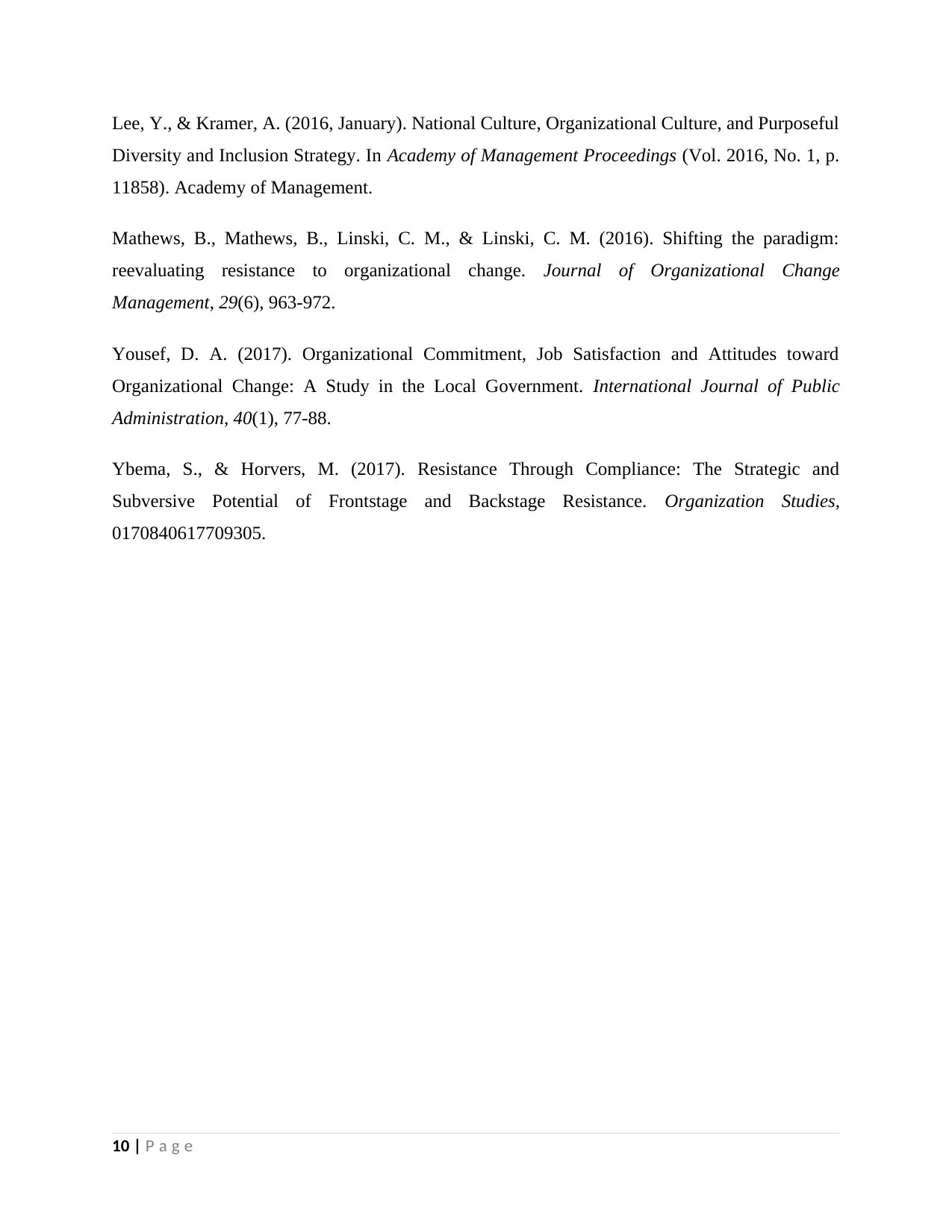
Lee, Y., & Kramer, A. (2016, January). National Culture, Organizational Culture, and Purposeful
Diversity and Inclusion Strategy. In Academy of Management Proceedings (Vol. 2016, No. 1, p.
11858). Academy of Management.
Mathews, B., Mathews, B., Linski, C. M., & Linski, C. M. (2016). Shifting the paradigm:
reevaluating resistance to organizational change. Journal of Organizational Change
Management, 29(6), 963-972.
Yousef, D. A. (2017). Organizational Commitment, Job Satisfaction and Attitudes toward
Organizational Change: A Study in the Local Government. International Journal of Public
Administration, 40(1), 77-88.
Ybema, S., & Horvers, M. (2017). Resistance Through Compliance: The Strategic and
Subversive Potential of Frontstage and Backstage Resistance. Organization Studies,
0170840617709305.
10 | P a g e
Diversity and Inclusion Strategy. In Academy of Management Proceedings (Vol. 2016, No. 1, p.
11858). Academy of Management.
Mathews, B., Mathews, B., Linski, C. M., & Linski, C. M. (2016). Shifting the paradigm:
reevaluating resistance to organizational change. Journal of Organizational Change
Management, 29(6), 963-972.
Yousef, D. A. (2017). Organizational Commitment, Job Satisfaction and Attitudes toward
Organizational Change: A Study in the Local Government. International Journal of Public
Administration, 40(1), 77-88.
Ybema, S., & Horvers, M. (2017). Resistance Through Compliance: The Strategic and
Subversive Potential of Frontstage and Backstage Resistance. Organization Studies,
0170840617709305.
10 | P a g e
1 out of 10
Related Documents
Your All-in-One AI-Powered Toolkit for Academic Success.
+13062052269
info@desklib.com
Available 24*7 on WhatsApp / Email
![[object Object]](/_next/static/media/star-bottom.7253800d.svg)
Unlock your academic potential
Copyright © 2020–2025 A2Z Services. All Rights Reserved. Developed and managed by ZUCOL.




